Decluttering by “Dropbox Shopping”
Flipping the script by forcing ourselves to “buy” our old stuff
“The process of decluttering in your later years is not just a physical act. It’s a psychological reckoning.”
— Jordan Legacy YouTube Channel
I wrote about a month ago about the decluttering process that our family has been going through. Marsha and I live in a 2-bedroom / 2.5 bathroom condo unit. It doesn’t hold that much, and the two of us have been pretty good (not claiming greatness) at avoiding clutter inside our unit. On the positive side, we are currently buying less new stuff. I also think we have a reasonable strategy for our storage room downstairs. However, we still have a big problem with our stuff up at the home of Marsha’s family-of-origin. I’m proposing a strategy of “Dropbox shopping” to potentially flip-the-script on the problem of deciding what to give away up there.
Buying less new stuff
While decluttering is not normally a one-time event and should be viewed as an ongoing process, we’ve made our lives easier with our retired, urban lifestyles. I see four dynamics that make me optimistic for a (more) decluttered future: a smaller footprint, digital goods, only replacing old items, and watching expenses.
Smaller footprint with urban life
We don’t have a whole garage full of stuff to live all different aspects of suburban life.
No yard to maintain
No workshop space to fix things in
No way to wash our own car
No outdoor grill or patio
No space for additional kitchenware
As such, we’ve already given away so much with no need or desire to replace any of it!
Digital goods
The digital era has allowed us to accumulate less “stuff.”
Books have been replaced with KIndle
Newspapers and magazine subscriptions are all electronic
Albums and CDs have been replaced with Spotify
DVDs and VHS have been replaced with streaming services
Photos now just go into iCloud
Paper files just get scanned and most docs are handled electronically anyway, eliminating the need for a lot of office supplies
Digital hoarding may become a problem, but with 2TB on Dropbox, 2TB on iCloud, and 1TB each on Microsoft OneDrive, we have a long way to go!
Only upgrading / replacing
In addition, at this point in our lives, we have all the “things” we need. As such, many new purchases simply replace items we had to give away or discard.
Clothes purchases have been reduced to replacing items that wear out (e.g., socks, shoes, etc.) I care less about the latest fashions at this point.
PCs, peripherals, and other gear have been replaced by Apple stuff which can be traded in once they are upgraded. (I just traded in my old 2020 Macbook Air M1 for $305!)
Printer ink is a subscription now, so we don’t stock that anymore.
Recent furniture purchases (new dining room chairs, new bar stools) were replacements, as we learned that faux leather dries out and cracks. It does not have the staying power of real leather furniture, so we upgraded.
Even our recent upgrade to an espresso machine replaced the collection of French presses that we used to use for coffee.
Given that our one car (a 2002 Audi TT ALMS) is 23 years old, we may have to get a new car soon, but we expect to do a replacement — not to have two cars!
Watching expenses
In many ways, for a successful retirement financial plan, the world is a lot simpler. Given that our kids are out of college now, we don’t watch income anymore, and we don’t really let the fluctuations in the market unnerve us by watching the portfolio too closely. As such, the only number we really watch is how much we spend. Just watching this number helps keep down the amount of “stuff” we buy that aren’t consumables. (It hasn’t stopped us from spending too much on the Portland restaurant and bar scene, however!)
Storage closet strategy
We have a storage closet down in our garage. While it’s still pretty full, I think there’s at least a strategy, both for what’s in there, as well as how to easily reduce its footprint.
Occasional Use Items
We have decided to keep some things that we use occasionally. These items include a 6 ft ladder (used when we have to do things like change batteries on our smoke alarms), a dolly (for moving heavy stuff in and out of our condo), “wheelie” luggage when we want to travel with more than what we normally just carry on, Christmas decorations, Halloween costumes, and a gelato machine. Truthfully, any of this stuff could go if it needed to without more than just occasional inconvenience.
“Deep freeze”
These are items we don’t intend to touch, including photos, college diplomas and awards, and baby books. We’ve actually culled this down quite a bit. I’ve already shredded my old high school and college yearbooks, the letters Marsha and I exchanged before we were married, and many old photos which I’ve already scanned. I intend to scan more! We also put our kids in charge of their own “deep freeze” items of old art projects, school work, and other mementos, and they proved far less emotional about their stuff than we were! So, what’s left is actually pretty small.
Artwork
We used to live in a suburban home, and our current urban condo has windows on the South and West sides. As such, we have a lot of artwork (much of which was painted by close family friends) that we’ve left in storage for now. If space becomes an issue, I may remove some of the art pieces from their frames and simply keep them in scrolls. Our younger daughter has already expressed a desire to eventually display some of this artwork when she has a home someday!
Empty boxes
This is somewhat irrational, but we have the original boxes for many of our larger items, including my Dell 34” monitor, Marsha’s sewing machines, and our vibration plate (a fitness device). Despite that we’ve now been here in Portland for 7 years, we have moved so many times that we’ve seen the value of keeping the original packaging when moving heavier, more expensive items across locations. We’re not planning to move any time soon (or even before the useful life of these items). As such, these boxes can be easily discarded as we have space needs, but for the time being, they serve as a way to fill up our storage closet so we don’t put more stuff in there!
Our old stuff
My parents did multiple moves from our suburban home growing up. They had places in downtown Seattle, San Francisco, Danville, and two different homes in Houston. As such, all of my stuff from childhood has been largely disposed of by now. Marsha’s stuff is another story entirely.
Marsha’s parents lived in the same house for over 50 years. All of her historical stuff is simply spread throughout the house, including old record albums, books, stuffed animals, art projects, and other tchotchke. Only a small amount of it is actually neatly stored away in boxes. We have a big job to go through her family keepsakes.
For background, I’ve only started cataloging some of the stuff here, and it just keeps going! Here’s a small sample that fits in a single screenshot.
I have no idea how long it is going to take to go through everything in that house. We have already taken multiple runs to Goodwill. Perhaps the easiest 10% of the stuff accumulated over the last 50+ years has been processed. So, is there really another 45 years worth of stuff to go through?
Our kids’ stuff
We have also stored a bunch of our kids’ stuff up there at the home of Marsha’s family-of-origin. The good news is that the kids have at least taken early passes through their stuff to try to minimize it a bit, and we’ve packed it into boxes. The bad news is that it is so voluminous.
My brother-in-law was a true hero and even procured shelving for their stuff. On one side of a storage room is largely our older daughter’s stuff.
On the other side of the room is our younger daughter’s stuff.
QR Codes and “Dropbox shopping”
For our younger daughter’s stuff, we are trying a new system. I’ve photographed the contents of each box and put QR codes outside the boxes that link to Dropbox folders containing the photos. As we take stuff from the boxes, we cross out the items from the photos to keep an inventory.
For example, Marsha went “shopping” in one of our younger daughter’s boxes (AL Box 009) that was storing sewing stuff.
So, I crossed out the items Marsha took out of the box on the photo linked to by the QR code on the label.
And, remotely from Chicago, our younger daughter has also “gone shopping” from her own stuff in the photos.
This was her request list for us to bring out to her the next time we come to visit:
Box 015 - The Stone Sky book
Hanging clothes - IMG_2566, IMG_2567
Box 005 - Picnic Blanket
Box 004 - Everything in IMG_2621, CMU Quarter Zip from IMG_2616
So, this is what I extracted for her:
The hope is that at least this system will save us the work of having to rummage through boxes looking for stuff! And perhaps it might be the basis of a strategy to really cull through it in the future.
A possible strategy for next steps
By definition, all of this stuff up at the home of Marsha’s family-of-origin is stuff that we’ve lived without for a long time. I think we have to flip-the-script. It’s not “what do we give away?” The problem with deciding whether to give something away brings up so many questions:
Am I properly respecting the giver of this item?
Do I value the activity this was a part of?
Is this item really useful to the recipient or organization I’m giving it to?
Is this going to just end up in a landfill?
What if I could use this in the future?
Will I regret giving this away?
All of these questions create too much fatigue.
Like with the “Dropbox shopping”, I am thinking we could flip the script from “what do we give away?” to “what do we buy?” By photographing all the items, we can decide by browsing online whether to “buy” them or not. The concept is that when we decide to “buy” the items out of a donation pile and decide to keep them, we agree to give their fair market value to charity as a cash gift.
So, either the stuff gets donated as a noncash gift, or we have to donate its value as a cash gift to charity if we don’t give it away.
Will this be a good psychological reframing?




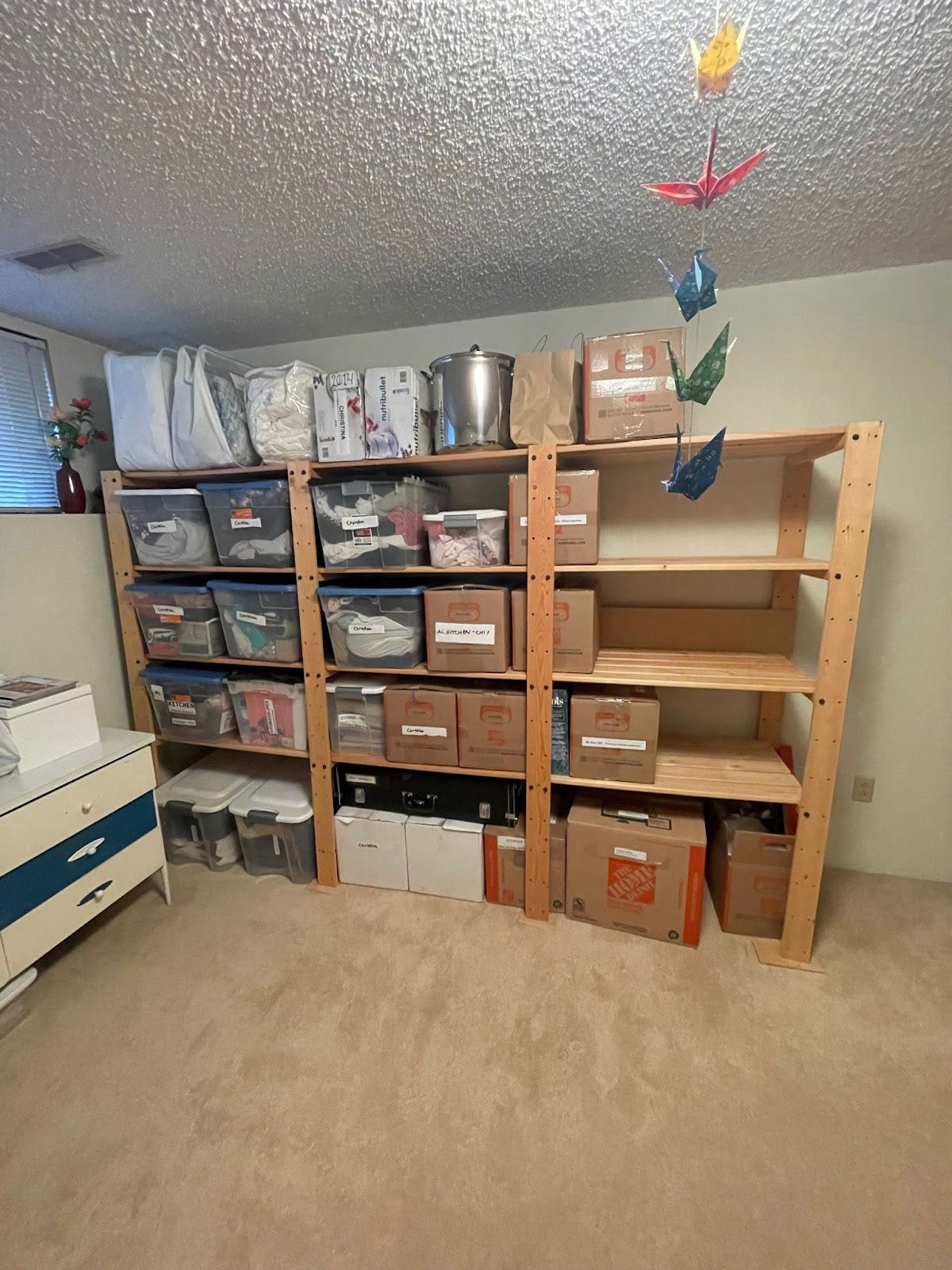
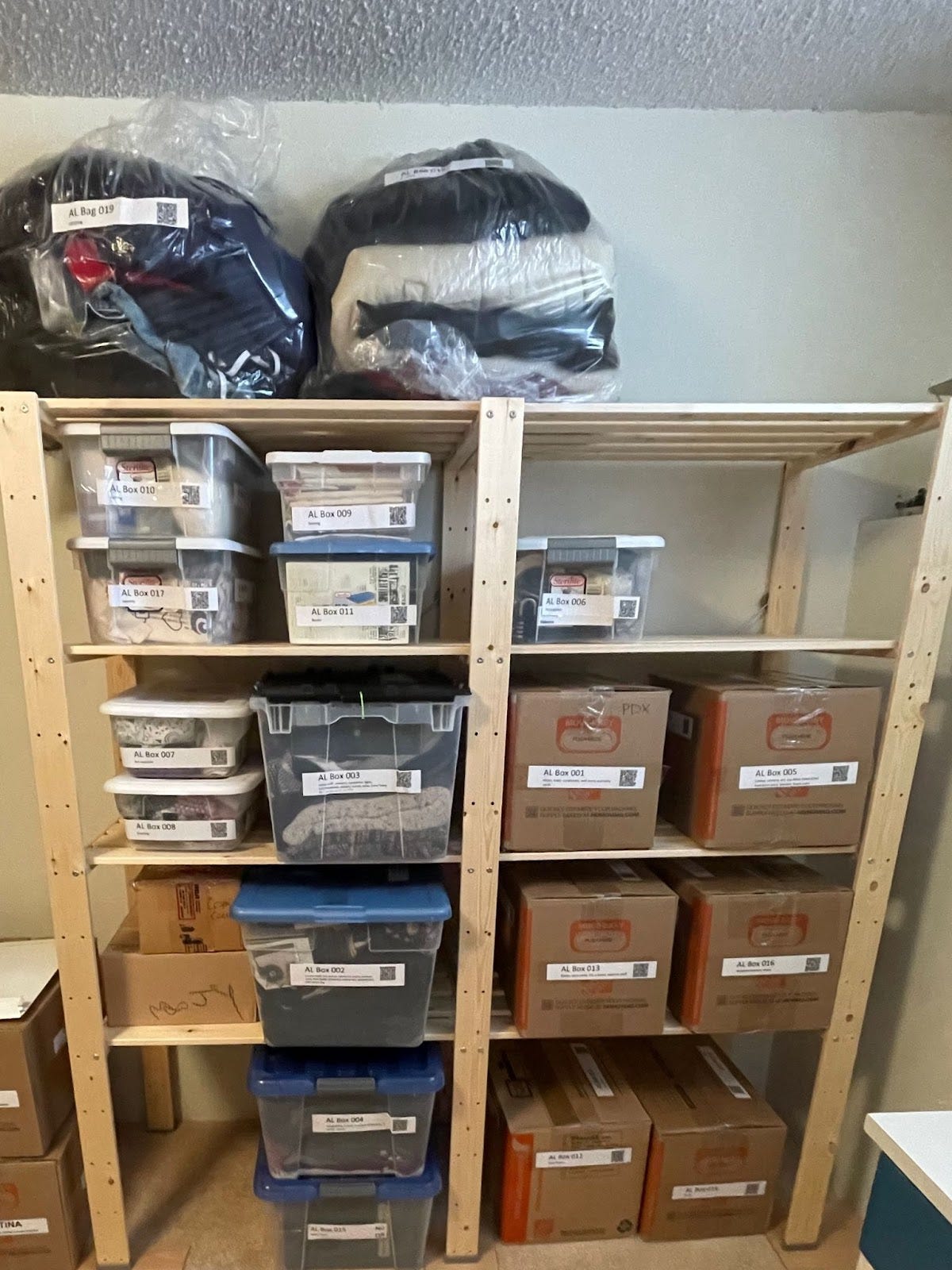
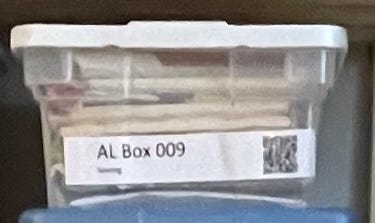
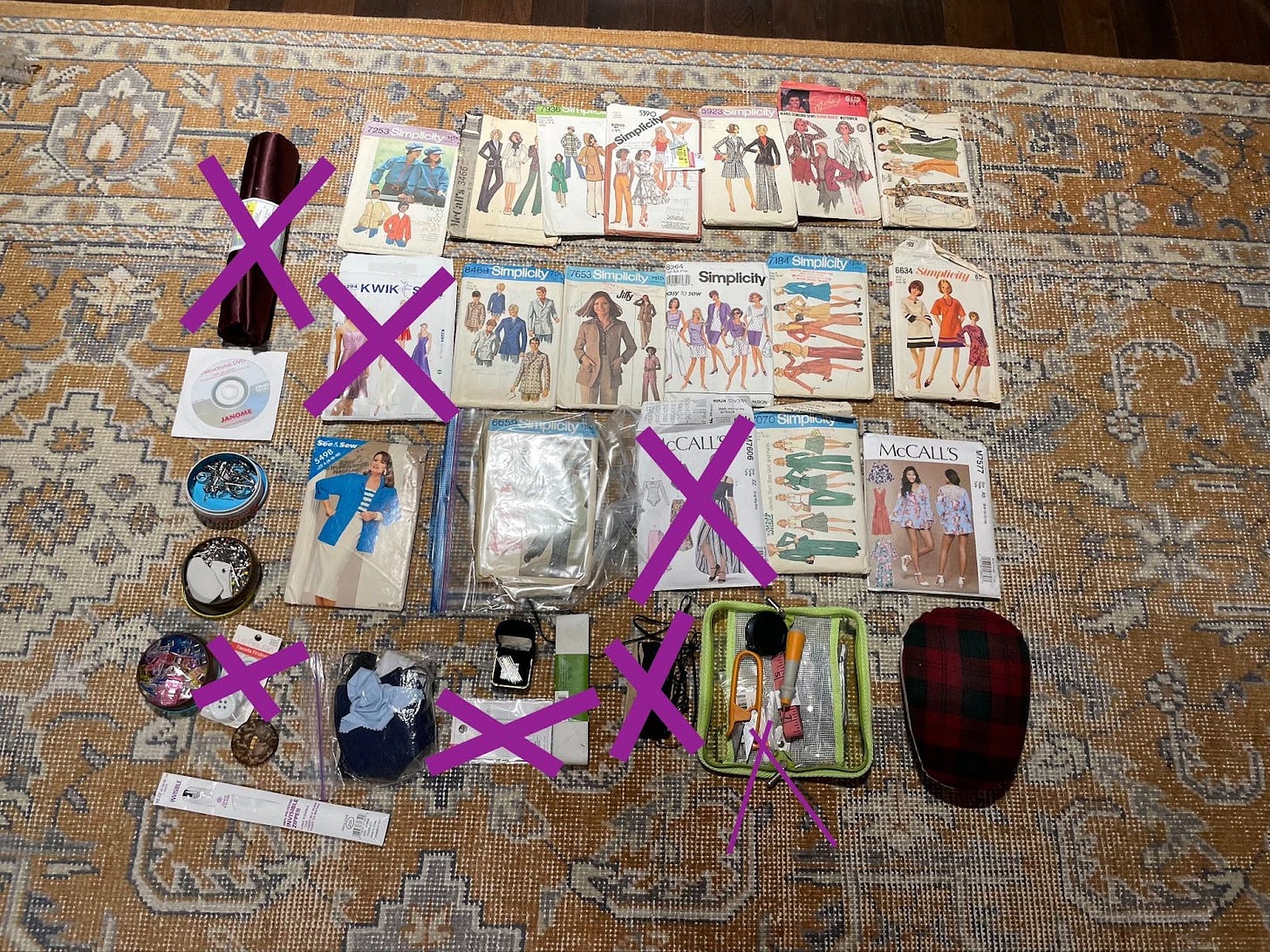
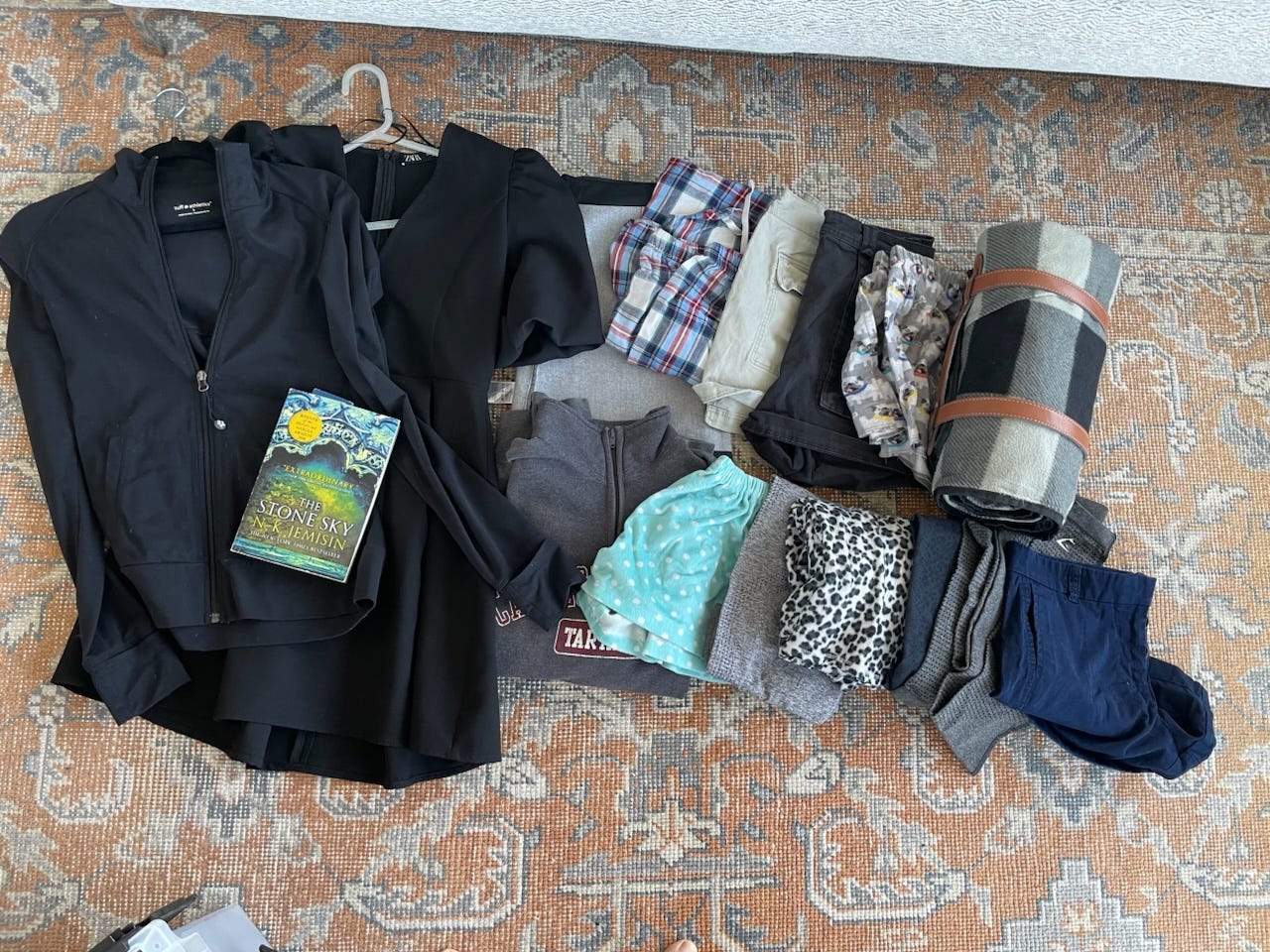
We (and AJ) found Viet Vets to be a great place for donations. They pick up at no cost, they sort, and distribute as appropriately (vets, Goodwill, Salvation Army, etc.).
Cool ideas!